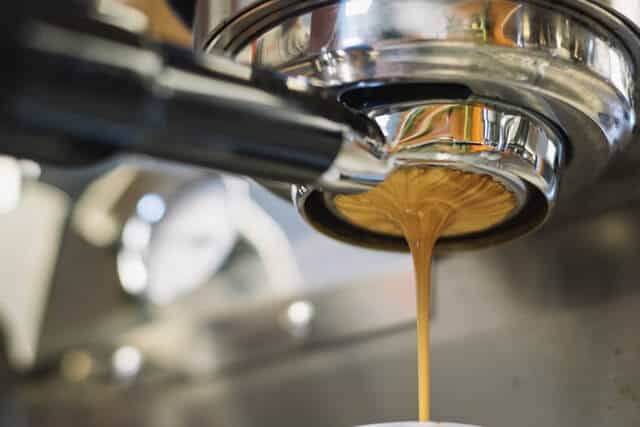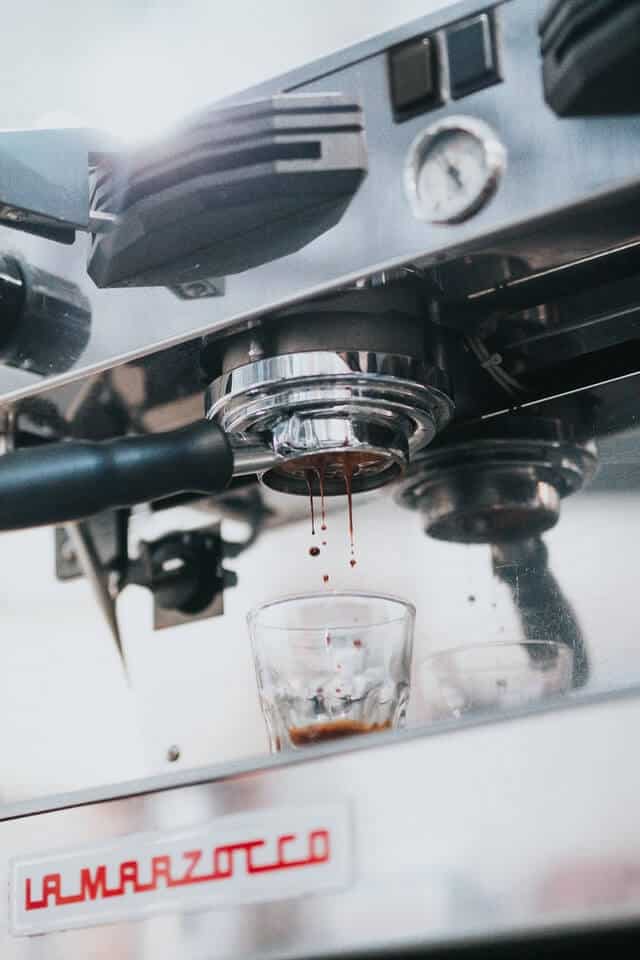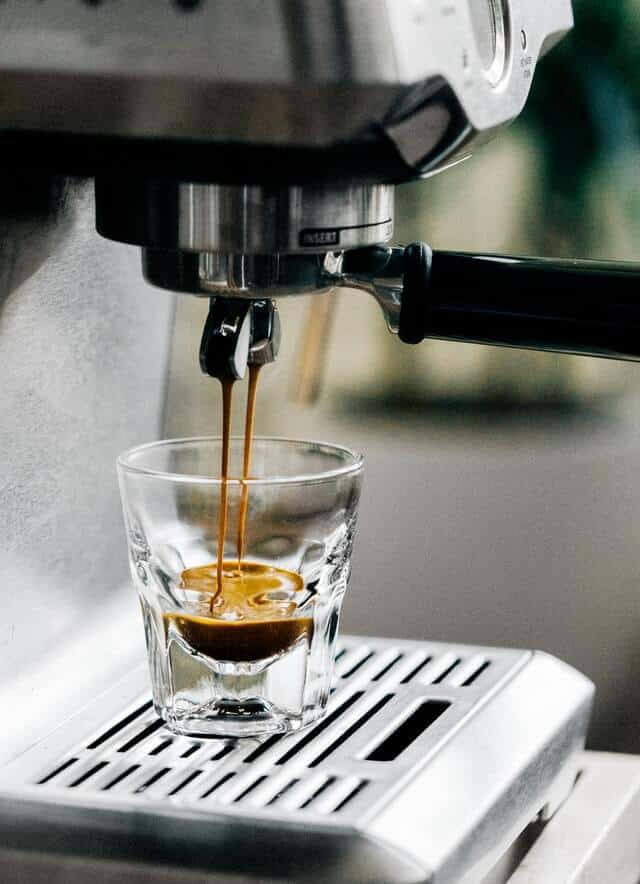As an Amazon Associate I earn from qualifying purchases. When you use our links, we may earn an affiliate commission. Learn more.
To make the ultimate espresso, you’ll have to perfect a bunch of factors, such as the dosing, tamping, temperature, time, etc. But if you select the wrong portafilter, most of your efforts will be in vain.
That’s why I decided to write this post. I’ll detail all the differences between a bottomless portafilter vs. regular.
Does the bottomless portafilter actually yield better shots? Or is it just a huge marketing gimmick? Let’s find out!

A bottomless portafilter during coffee extraction
Design
In a regular, aka spouted, portafilter, the espresso doesn’t flow directly into the cup. It has to drip on the portafilter’s bottom before it seeps through the single or double spouts.
As the name suggests, a bottomless portafilter has neither a bottom nor a spout. After attaching it to the machine, you’ll be able to see the espresso as it drips from the basket’s screen into your cup. Some people call it a “naked” portafilter since it displays what the other model hides.
Can the Basket Slip From a Bottomless Portafilter?
No. All baskets don’t depend on the portafilter’s bottom for support.
Alternatively, they have wide rims that rest on the top of the portafilter. To improve stability, every portafilter comes with a retractable ring that locks the basket in place after you insert it. You even have to push hard enough until you hear a “click” sound, confirming that the basket is now resting in the ideal position.
Espresso Troubleshooting
As you might already know, espresso needs an experienced barista who can fine-tune all the variables and avoid under or over-extraction. But there are some problems that no barista can fix unless they see the espresso as it drips from the basket.
To put things into perspective, let’s talk about one of the most critical and common problems — channeling.
What Is Channeling?
When you tamp your well-dosed grounds evenly inside the portafilter, you’ll force the water to seep uniformly through the puck, resulting in a balanced extraction.
But if you rush the tamping process, your puck will have varying levels of compactness and resistance. This is bad because water will only pass through the areas, or “channels”, that have the least resistance. If this happens, you’ll be left with a chaotic cup that has both under-extracted and over-extracted tones.
Diagnosing the Problem With Both Portafilters
If the channeling occurs while using a bottomless portafilter, you’ll see those channels for yourself since you have direct access to the basket’s screen.

A Bottomless Portafilter can prove very useful in identifying channeling
You can evaluate the number of channels, their direction, orientation, speed, etc. Then, you can use this data to reflect on your process. For instance, a large number of channels over the peripheries suggest that your tamper doesn’t exert enough pressure in that area.
With enough time, you’ll have a detailed plan for making the perfect espresso possible!
On the other hand, a spouted portafilter obscures all of these valuable insights. Any channeling would be streamlined into a perfect pour, tricking you into believing that you have an ideal process.
This free cheat sheet will improve your coffee brew by providing quick information on brew ratio, grind size, optimal brewing time, and more.
Maintenance and Cleaning
Cleaning a portafilter is quite hard. First, you have to unscrew the spout so that you can clean all the nooks and crannies. Then, you’ll have to scrape deep enough into the bottom to remove all the remaining coffee.

Cleaning a Regular Portafilter can be quite hard
After a couple of weeks, you’ll have to dip your portafilter into a professional cleaning solution to dissolve the hardened stains. After you finish, you must rinse well to ensure that you remove all the slimy cleaning solution.
Because the bottomless portafilter has a smaller surface area, cleaning them is much more convenient. Just flush them with some water after each use and you’ll be good to go!
Splashing
Although cleaning a bottomless portafilter is easier, it might leave your countertop messier than a spouted model.
How? Well, this traces back to the channeling issue that I discussed earlier. If the tamping was really horrible, water will forcefully gush through the basket’s screen. If you’re lucky, that splashing won’t cross the drip tray. But in some cases, it can fall over the countertop or even your clothes!
When using a spouted portafilter, splashing becomes almost impossible. Any gushing channels will hit the portafilter’s bottom before flowing smoothly into the spout.
Crema & Taste
Some baristas claim that a bottomless portafilter yields a thicker crema with a richer taste than a spouted model.
They argue that some of the crema inevitably sticks to the metallic spout, leaving slightly less amount for your shot. Furthermore, if the spout is cold, it’ll drop a colder crema that sinks into the cup faster than usual.
Does this result in a sizable difference? In my experience, no. If you perfect your technique, the quality will be optimal with both portafilters.
Then how come the opinions are so discordant on this matter? I think this may have to do with the troubleshooting advantage of a bottomless portafilter. It helps you pinpoint the problem so that you can fix it and pull better shots, which isn’t as easy with a spouted model.
Pulling Two Shots
If you serve coffee for a living, you should definitely own a double-spout portafilter.
When using two spouts, you can pull two shots at the same time, which will be quite handy if you have too many clients waiting in a queue that doesn’t seem to end.
But if you’re making espresso at home, a bottomless portafilter will do. In fact, a double-spout may not even fit inside a single cup.
The Final Word: Which Portafilter Should You Get?
If possible, get both!
A bottomless portafilter will help you analyze your technique to discover the things you’re doing wrong. Eventually, you’ll accumulate this knowledge until you can pull a perfect shot.
Even though a spouted portafilter will barely give you any insights, it’ll be super handy when you don’t have time to deal with the spills that a bottomless model might leave.
If you’re a professional barista, a double-spout portafilter will save you considerable time and effort by pulling two shots at once.
Hope this helped. See you with another detailed espresso analysis!
Brooke Davis
Hi everyone, my name is Brooke and I’m a Barista and freelance writer. I love brewing coffee and my favorite coffee drink is without doubt an Americano (espresso with added hot water). When I’m not busy making or writing about coffee you’ll find me hanging out at the beach with friends in California where I am currently residing. Follow me on: LinkedinThis free cheat sheet will improve your coffee brew by providing quick information on brew ratio, grind size, optimal brewing time, and more.